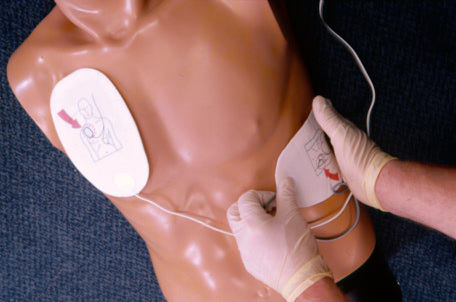|
Automated External
Defibrillators (AED) for Aquatic Emergencies
 This
course represents entry-level training designed to educate the general
diving (and qualified non-diving) public to better recognize the warning
signs of Sudden Cardiac Arrest and administer first aid using Basic Life
Support techniques and Automated External Defibrillators while activating
the local emergency medical services, (EMS) and / or arranging for
evacuation to the nearest appropriate medical facility. This
course represents entry-level training designed to educate the general
diving (and qualified non-diving) public to better recognize the warning
signs of Sudden Cardiac Arrest and administer first aid using Basic Life
Support techniques and Automated External Defibrillators while activating
the local emergency medical services, (EMS) and / or arranging for
evacuation to the nearest appropriate medical facility.
- In the United States, sudden cardiac arrest claims more than 225,000
to 250,000 lives a year, according to the American Heart Association.
- Ninety three percent of the people involved in a submersion incident
die from cardiac arrest.
Most common cause of sudden cardiac arrest is ventricular fibrillation.
There are several causes of ventricular fibrillation including:
- Cardiovascular disease
- Drowning
- Hypothermia
- Electrical shock
The only definitive treatment for ventricular fibrillation is
defibrillation. This course teaches lay-providers to use an automated
external defibrillator to defibrillate a fibrillating heart and restore a
normal rhythm.
 Course
Objective Course
Objective
This course, DAN Automated External Defibrillators (AEDs) for Aquatic
Emergencies, represents entry-level training designed to educate the
general public to better recognize the warning signs of Sudden Cardiac
Arrest and administer first aid using Basic Life Support techniques and
Automated External Defibrillators while activating the local emergency
medical services (EMS) and / or arranging for evacuation to the nearest
appropriate medical facility.
Recommended Minimum Hours of Training
Knowledge Development (Lecture) = 1 Hour
Skills Development (Practice) = 2-3 Hours
Learning Objectives
At the end of this program, Automated External Defibrillators (AEDs) for
Aquatic Emergencies course, participants will be able to:
- Recognize the warning signs of sudden cardiac arrest.
- Provide Basic Life Support while setting up the automated external
defibrillator.
- Provide basic life support with an AED.
- Care for and maintain an AED.
This course does not provide training for cardiopulmonary resuscitation
(CPR) or water rescue. The training exercises of this course presuppose
that the ill or injured person is already out of the water.
Skill Performance Objectives
To successfully complete the Automated External Defibrillators (AEDs) for
Aquatic Emergencies course, participants must demonstrate skill and
confidence in:
- Providing Basic Life Support.
- Securing and setting up the Automated External Defibrillator.
- Providing care with an Automated External Defibrillator.
|